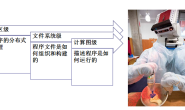描述
机械臂末端的位姿是p时,不想沿着基坐标系来移动,而是想沿着末端的xyz轴来移动
接口代码
核心函数
# 移动
def move_endEffector(axis, dist, x, y, z, rx, ry, rz):
Rx = np.mat([[1, 0, 0], [0, math.cos(rx), -math.sin(rx)], [0, math.sin(rx), math.cos(rx)]])
Ry = np.mat([[math.cos(ry), 0, math.sin(ry)], [0, 1, 0], [-math.sin(ry), 0, math.cos(ry)]])
Rz = np.mat([[math.cos(rz), -math.sin(rz), 0], [math.sin(rz), math.cos(rz), 0], [0, 0, 1]])
R = Rz * Ry * Rx
unitVector = np.mat([[0], [0], [1]])
T = R*unitVector
pose_move = [0.0] * 6
if axis == "x":
pose_move[0]=dist
if axis == "y":
pose_move[1]=dist
if axis == "z":
pose_move[2]=dist
T_move= getT_fromPose(pose_move[0],pose_move[1],pose_move[2],pose_move[3],pose_move[4],pose_move[5])
T_now = getT_fromPose(x, y, z, rx, ry, rz)
T_moveTarget = T_now*T_move
pose = getPose_fromT(T_moveTarget)
output_x = pose[0]
output_y = pose[1]
output_z = pose[2]
rx = pose[3]
ry = pose[4]
rz = pose[5]
return output_x, output_y, output_z, rx, ry, rz
#旋转
def spin_endEffector(axis, angle, x, y, z, rx, ry, rz):
Rx = np.mat([[1, 0, 0], [0, math.cos(rx), -math.sin(rx)], [0, math.sin(rx), math.cos(rx)]])
Ry = np.mat([[math.cos(ry), 0, math.sin(ry)], [0, 1, 0], [-math.sin(ry), 0, math.cos(ry)]])
Rz = np.mat([[math.cos(rz), -math.sin(rz), 0], [math.sin(rz), math.cos(rz), 0], [0, 0, 1]])
R = Rz * Ry * Rx
unitVector = np.mat([[0], [0], [1]])
T = R*unitVector
pose_spin = [0.0] * 6
if axis == "x":
pose_spin[3]=angle/180.0*math.pi
if axis == "y":
pose_spin[4]=angle/180.0*math.pi
if axis == "z":
pose_spin[5]=angle/180.0*math.pi
print(axis)
print(pose_spin)
T_spin= getT_fromPose(pose_spin[0],pose_spin[1],pose_spin[2],pose_spin[3],pose_spin[4],pose_spin[5])
T_now = getT_fromPose(x, y, z, rx, ry, rz)
T_spinTarget = T_now*T_spin
pose = getPose_fromT(T_spinTarget)
output_x = pose[0]
output_y = pose[1]
output_z = pose[2]
rx = pose[3]
ry = pose[4]
rz = pose[5]
return output_x, output_y, output_z, rx, ry, rz
需要调用的函数
我把需要用的代码贴在这里,讲解在另外一篇博客里欧氏空间位姿与变换矩阵的转换
def getPose_fromT(T):
x = T[0, 3]
y = T[1, 3]
z = T[2, 3]
rx = math.atan2(T[2, 1], T[2, 2])
ry = math.asin(-T[2, 0])
rz = math.atan2(T[1, 0], T[0, 0])
return x, y, z, rx, ry, rz
def getT_fromPose(x, y, z, rx, ry, rz):
Rx = np.mat([[1, 0, 0], [0, math.cos(rx), -math.sin(rx)], [0, math.sin(rx), math.cos(rx)]])
Ry = np.mat([[math.cos(ry), 0, math.sin(ry)], [0, 1, 0], [-math.sin(ry), 0, math.cos(ry)]])
Rz = np.mat([[math.cos(rz), -math.sin(rz), 0], [math.sin(rz), math.cos(rz), 0], [0, 0, 1]])
t = np.mat([[x], [y], [z]])
R = Rz * Ry * Rx
R_ = np.array(R)
t_ = np.array(t)
T_1 = np.append(R_, t_, axis = 1)
zero = np.mat([0,0,0,1])
T_2 = np.array(zero)
T = np.append(T_1, T_2, axis = 0)
T = np.mat(T)
return T
使用例子
python例子
import math
import numpy as np
import scipy.linalg as la
def move_endEffector(axis, dist, x, y, z, rx, ry, rz):
Rx = np.mat([[1, 0, 0], [0, math.cos(rx), -math.sin(rx)], [0, math.sin(rx), math.cos(rx)]])
Ry = np.mat([[math.cos(ry), 0, math.sin(ry)], [0, 1, 0], [-math.sin(ry), 0, math.cos(ry)]])
Rz = np.mat([[math.cos(rz), -math.sin(rz), 0], [math.sin(rz), math.cos(rz), 0], [0, 0, 1]])
R = Rz * Ry * Rx
unitVector = np.mat([[0], [0], [1]])
T = R*unitVector
pose_move = [0.0] * 6
if axis == "x":
pose_move[0]=dist
if axis == "y":
pose_move[1]=dist
if axis == "z":
pose_move[2]=dist
T_move= getT_fromPose(pose_move[0],pose_move[1],pose_move[2],pose_move[3],pose_move[4],pose_move[5])
T_now = getT_fromPose(x, y, z, rx, ry, rz)
T_moveTarget = T_now*T_move
pose = getPose_fromT(T_moveTarget)
output_x = pose[0]
output_y = pose[1]
output_z = pose[2]
rx = pose[3]
ry = pose[4]
rz = pose[5]
return output_x, output_y, output_z, rx, ry, rz
def rotate_endEffector(axis, angle, x, y, z, rx, ry, rz):
Rx = np.mat([[1, 0, 0], [0, math.cos(rx), -math.sin(rx)], [0, math.sin(rx), math.cos(rx)]])
Ry = np.mat([[math.cos(ry), 0, math.sin(ry)], [0, 1, 0], [-math.sin(ry), 0, math.cos(ry)]])
Rz = np.mat([[math.cos(rz), -math.sin(rz), 0], [math.sin(rz), math.cos(rz), 0], [0, 0, 1]])
R = Rz * Ry * Rx
unitVector = np.mat([[0], [0], [1]])
T = R*unitVector
pose_rotate = [0.0] * 6
if axis == "x":
pose_rotate[3]=angle/180.0*math.pi
if axis == "y":
pose_rotate[4]=angle/180.0*math.pi
if axis == "z":
pose_rotate[5]=angle/180.0*math.pi
T_rotate= getT_fromPose(pose_rotate[0],pose_rotate[1],pose_rotate[2],pose_rotate[3],pose_rotate[4],pose_rotate[5])
T_now = getT_fromPose(x, y, z, rx, ry, rz)
T_rotateTarget = T_now*T_rotate
pose = getPose_fromT(T_rotateTarget)
output_x = pose[0]
output_y = pose[1]
output_z = pose[2]
rx = pose[3]
ry = pose[4]
rz = pose[5]
return output_x, output_y, output_z, rx, ry, rz
def getPose_fromT(T):
x = T[0, 3]
y = T[1, 3]
z = T[2, 3]
rx = math.atan2(T[2, 1], T[2, 2])
ry = math.asin(-T[2, 0])
rz = math.atan2(T[1, 0], T[0, 0])
return x, y, z, rx, ry, rz
def getT_fromPose(x, y, z, rx, ry, rz):
Rx = np.mat([[1, 0, 0], [0, math.cos(rx), -math.sin(rx)], [0, math.sin(rx), math.cos(rx)]])
Ry = np.mat([[math.cos(ry), 0, math.sin(ry)], [0, 1, 0], [-math.sin(ry), 0, math.cos(ry)]])
Rz = np.mat([[math.cos(rz), -math.sin(rz), 0], [math.sin(rz), math.cos(rz), 0], [0, 0, 1]])
t = np.mat([[x], [y], [z]])
R = Rz * Ry * Rx
R_ = np.array(R)
t_ = np.array(t)
T_1 = np.append(R_, t_, axis = 1)
zero = np.mat([0,0,0,1])
T_2 = np.array(zero)
T = np.append(T_1, T_2, axis = 0)
T = np.mat(T)
return T
# 随便设置了一个位姿
pose_now = [-0.072944147641399, -0.06687830562048944, 0.4340418493881254, -0.2207496117519063, 0.0256862005614321, 0.1926014162476009]
# 得到目标位置的位姿
# 沿x轴移动5cm
pose_move_x = move_endEffector("x", 0.05, pose_now[0], pose_now[1], pose_now[2], pose_now[3], pose_now[4], pose_now[5])
print(pose_move_x)
# 沿y轴移动-5cm
pose_move_y = move_endEffector("y", -0.05, pose_now[0], pose_now[1], pose_now[2], pose_now[3], pose_now[4], pose_now[5])
print(pose_move_y)
# 沿z轴旋转0.05弧度
pose_rotate_z = rotate_endEffector("z", 0.05, pose_now[0], pose_now[1], pose_now[2], pose_now[3], pose_now[4], pose_now[5])
print(pose_rotate_z)
# 沿x轴旋转-0.05弧度
pose_rotate_x = rotate_endEffector("x", -0.05, pose_now[0], pose_now[1], pose_now[2], pose_now[3], pose_now[4], pose_now[5])
print(pose_rotate_x)




